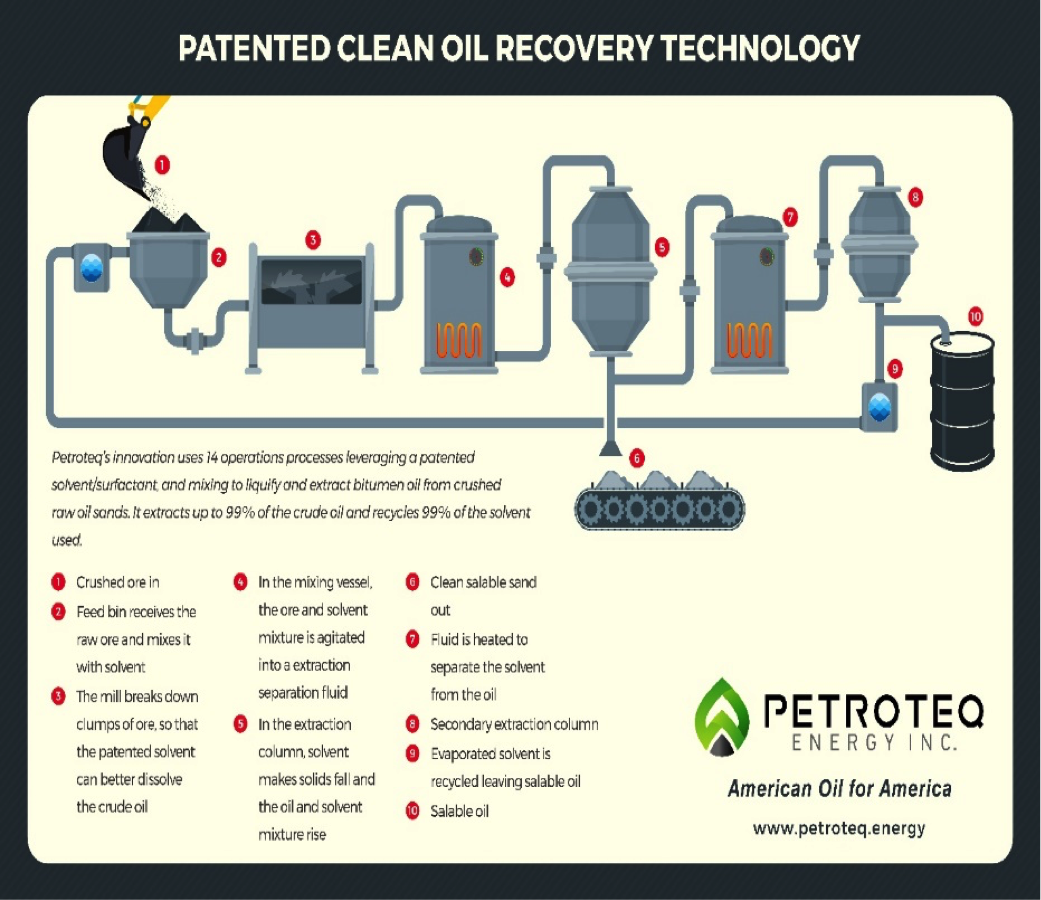Oil sands are a type of unconventional oil that is a mixture of sand and dense, viscous bitumen. Utah contains approximately 55 percent of U.S. oil sands deposits, concentrated in eight major areas with a total resource volume of over 30 billion barrels.
Petroteq, a Canada-based company, is leading the charge to extract this valuable commodity. The technology they use is different from other oil sands projects in that it consists of solvents that can separate oil from rocks at little cost and with no water or air pollution. It is a “closed-loop” process that perpetually reuses the proprietary solvents. The company claims the break-even price is $32 a barrel, including all costs and taxes—less than half the current price for crude oil.
Currently, 20 people are employed on the project, producing 250 barrels a day. When the newly expanded plant begins commercial operation, it will process 50 to 70 tons of oil sands per hour with an output of 1,000 barrels a day, which will be shipped 150 miles by truck to refineries in Salt Lake City, where it will be processed into diesel fuel. The goal of the developers is to produce 5,000 barrels a day in three years. The company has leased over 2,500 acres of private land, holding 86 million barrels of oil, and believes it will eventually be able to produce 10,000 barrels a day over 25 years.
The process Petroteq uses consists of mining and crushing the oil-saturated sands into three-quarter inch chunks and moving them along a 150-foot conveyor belt into a tank where they are mixed with solvents that are “benign,” according to the company. The mix is then transferred to a second tank, where a centrifuge spins the lumpy liquid, separating the oil from the sands. Clean sand is moved to a reclamation landfill and the solvents are distilled out of the oily liquid and recycled again.
Because the chunks are a consistent size, they move through the process easily and the greater surface area provides a more complete extraction, lessening the time in the mixing tank.
The company claims the process is cleaner than oil sands mining in Canada, which is more water-intensive and leaves toxic tailing ponds. In the Petroteq process, no water is involved. Further, virtually no chemicals are left in the sand that is put back. Water is sprayed on the recycled sands so they do not blow away.
The extraction technology is the result of almost five years of work by Petroteq’s research and engineering teams. Petroteq gradually enhanced and improved the efficiencies of its technology at each stage of fabrication with better dryer/mixer components and a higher consistency of oil sands flow. This extraction technology is versatile: it can be applied to both “water-wet” deposits (such as the oil sands projects in Alberta, Canada) or the “oil-wet” deposits such as the resources typically found in Utah. The oil sands in Venezuela and Canada are typically found deep in the earth, mixed with water, sand, and clay in a semi-solid natural deposit.
HERE’S HOW PETROTEQ’S EXTRACTION TECHNOLOGY WORKS
Preparatory Stage: Mining and crushing of the oil sands ore to prepare for processing.
Stage 1: Crushed ore delivered into patented fluidized bed extractor. Extraction process is performed at temperatures between 50-60 C degrees
Stage 2: Solvent composition with extracted oil bitumen is delivered from extraction column to the evaporator and then to distillation column.
Stage 3: Hydrocarbons (oil/bitumen) are extracted from the solvent in the distillation column and pumped to the storage tank.
Stage 4: Solvent is recycled, warmed up and returned back to the extractor within the continuous flow, closed-loop system.
Stage 5: Purified sands leave extractor and go through the drying process.
At this point, the extracted crude oil is free of sand and solvents. It is then pumped out of the system and into a storage tank. The sand exits the extraction system as clean, dry sands, which can be sold or replaced to its origin. Any heat generated during the process may also be recycled. The crude oil produced is very low in sulfur content (reducing refinery costs for added processing) and the average API range for Utah oil sands is excellent at 14 API, making it much easier to transport. –From Petroteq Energy Inc.

Conclusion
Oil sands resources abound in the United States, but the technology was not sufficient to produce it economically until now. Petroteq believes it can do so, adding to our supply of diesel fuel. While initially, it will produce 1,000 barrels per day, it expects to eventually produce 10,000 barrels per day for 25 years with no water or air pollution. If the company succeeds, it will mark another chapter in the quest to unlock the United States’ enormous energy resources using new technologies.



